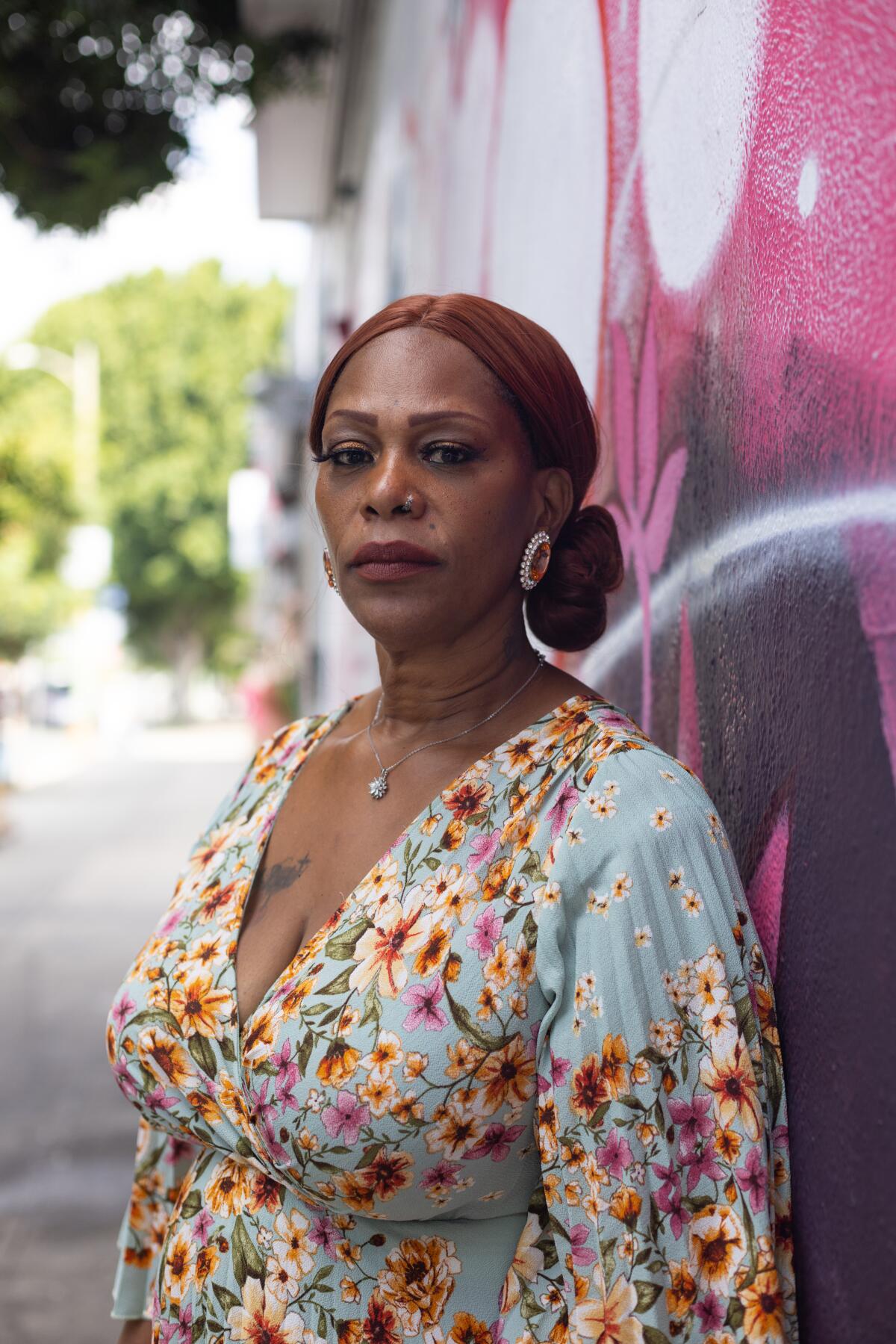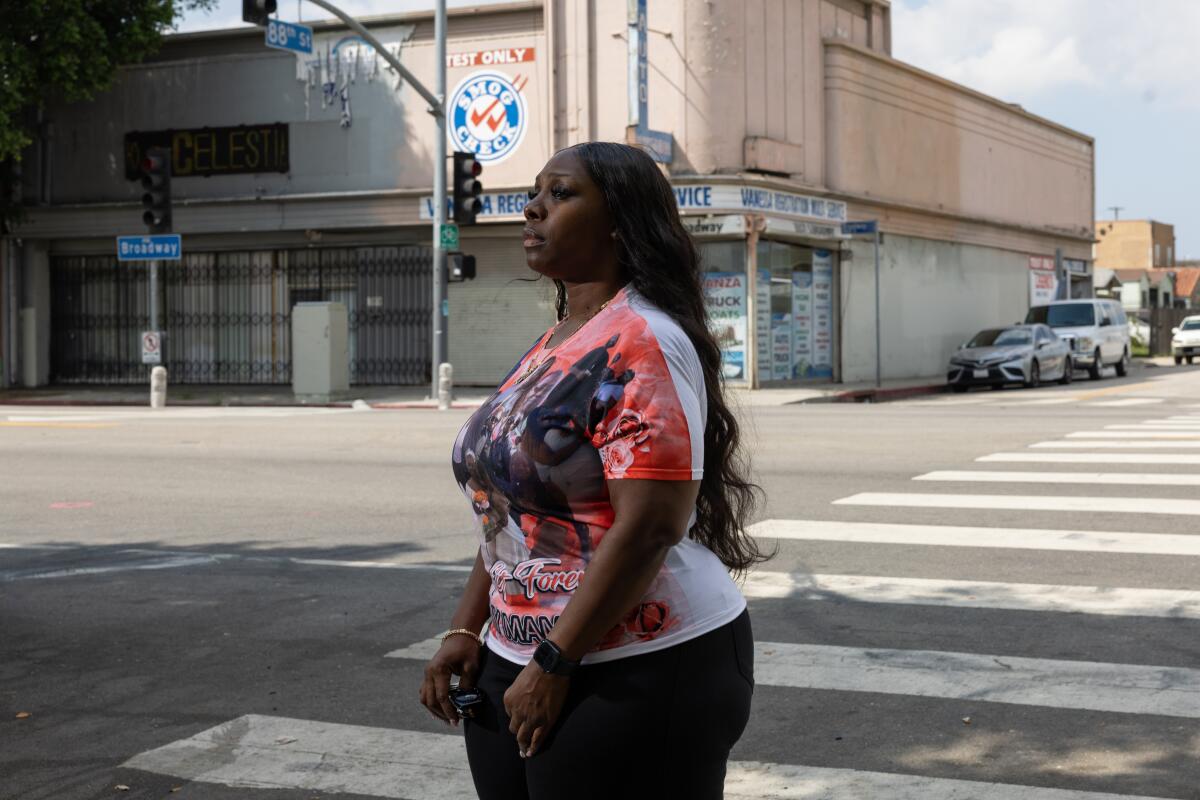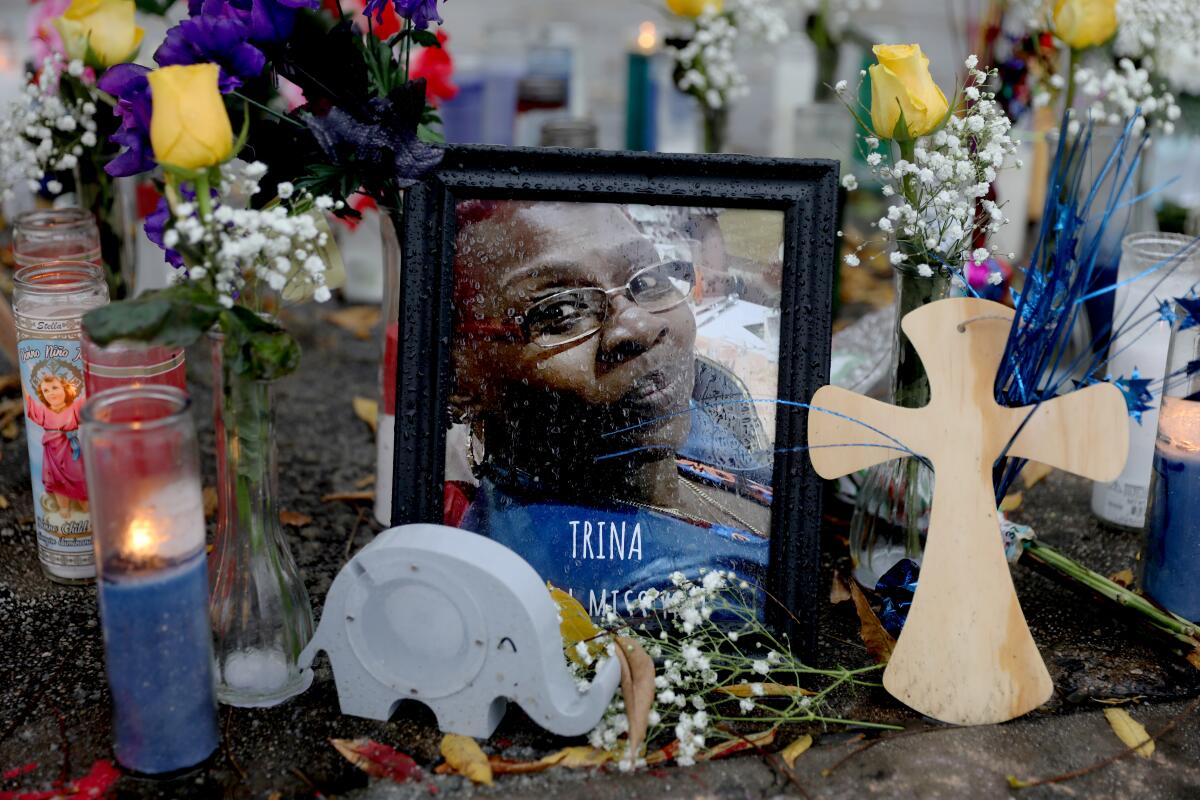Speed cameras: California’s answer to rising traffic deaths?

- Share via
Trina Newman-Townsend’s girls packed into her Ford Flex after delivering gifts, turkeys and hams to a Los Angeles shelter. It was Christmas Eve, and the recently wed 62-year-old pastor — mother of two, foster mother of five and grandmother of 11 — had a pajama gift exchange to attend later that night.
A speeding driver struck Newman-Townsend at 3:23 p.m. as she walked to open her car door. The impact was so powerful, she was partially dismembered. Four of her foster children were waiting in the car.
She was pronounced dead at the scene.
Her husband, Curtis Townsend Sr., was down the street at their home, preparing dinner. He rushed to her but was too late. He lay next to her lifeless body.

Distraught and wanting justice for her friend, Darlene Smith — who considered Newman-Townsend a sister — became one of dozens of traffic safety advocates who pushed state legislators to adopt a speed camera pilot program.
On Friday, Gov. Gavin Newsom signed the legislation into law, allowing the cameras in Los Angeles, San Jose, Oakland, Glendale, Long Beach and San Francisco. It is the first time California will permit speed cameras, and it comes after more than half a dozen attempts to pass similar legislation.
“This means the world to me. At least we will have something that will make people accountable,” Smith said.
The bill, principally authored by Assemblywoman Laura Friedman (D-Burbank), will allow cities to install cameras around schools, high injury networks — streets with the highest rates of injury and death — and areas known as street-racing corridors, as part of a five-year pilot program.
Under the law, the cameras will issue warnings for the first two months, and then for the first violation for driving 11 to 15 mph over the speed limit. The legislation also caps the number of cameras at 125 in the most populous cities such as Los Angeles.
The law comes amid an alarming rise in traffic deaths as officials and advocates debate the role of policing in road safety.
Proponents say the cameras differ from the unsuccessful red light program that was scrapped in Los Angeles. Those devices documented when drivers entered the intersection on a red light, but fines often went unpaid and their effectiveness was questioned. Unlike the red light cameras, speed camera violations have no criminal penalties and don’t add points against a driver’s license at the state Department of Motor Vehicles.
“The bill is intended to save lives and manage those that are driving recklessly fast,” said Damian Kevitt, executive director of Streets Are for Everyone, an advocacy group in Los Angeles that has been placing painted white tires along the roads where bicyclists and pedestrians have been killed.
He said the cameras will be an effective way to enforce the law without increasing the drivers’ interactions with patrol officers.
“Enforcement has become a bad word if you include police,” he said.
Pedestrian deaths across the country are at a 41-year high. In California about 1,100 people died last year after being hit by vehicles. Speed is a factor in about a third of all fatal traffic collisions, according to the National Highway Traffic Safety Administration.
But some privacy advocates fear the measure will increase surveillance — and that the speeding tickets could place a heavy burden on the most economically vulnerable communities.
“Automated enforcement mechanisms often disproportionately ticket drivers in communities of color and communities experiencing poverty,” Becca Cramer-Mowder, a legislative advocate at the ACLU California Action, told lawmakers earlier this year.
She said cities should concentrate on making roads safer with measures such as roundabouts or speed bumps instead of ticketing people who can least afford it.
The law allows cities to fine the vehicle owner $50 for speeds 11 to 15 mph over the limit. The charges get progressively steeper after that, rising to $500 for going more than 100 mph.
For the record:
5:21 p.m. Jan. 2, 2024An earlier version of this article said that fines for speeding violations caught on automated speed cameras will be issued to drivers. Fines will be issued to registered vehicle owners, who could be a different person than the driver.
Under the law, cities and transit agencies would run the program, not police. It would require fines be cut by 80% for those with incomes under the poverty line, and by 50% for those earning as much as 250% above the poverty level. It would also allow people to do community service in lieu of making a payment.
Opponents worry those measures aren’t enough to shield those living in disadvantaged communities.
“Not only can you get multiple tickets, but the people who are going to be disproportionately affected are the people who live in historically disinvested neighborhoods” said James Burch, deputy director of the Anti-Police Terror Project, an Oakland group that seeks to end overpolicing. “This is not what Oakland and cities throughout the state are asking for.”
Revenue generated from the tickets must be spent on the program and additional traffic-calming measures — and nothing else.
Smith, who grew up with Newman-Townsend in South L.A. during the height of gang violence, said she’s now more worried about cars than guns in the neighborhood.
“The cars are now the weapons,” she said as she stood across from a mural of her friend. “Too many families are being torn apart.”

The day of the crash, Newman-Townsend’s daughter Callie Harvey, 37, had been been planning to meet a cousin when she heard her mom had been hit by a car. She rushed to the scene.
“I pulled up on the opposite side of the street and I got out of the car,” she said. The crowd looked shell-shocked. A man tried to stop her as she walked toward the scene.
“He was like you don’t want to go there, and I lost it because I looked past him and I saw the sheet,” she said. “That day I lost a piece of myself.”

Newman-Townsend was so beloved that people still come by to leave candles or flowers nearly a year after the crash, said a man who works nearby.
The stretch of South Broadway near 88th Street where Newman-Townsend died is in the high-injury network, where a disproportionate number of injurious and fatal crashes occur. In recent years, South Los Angeles has led the city in traffic deaths. And studies show that across the country Black and Latino residents die at higher rates than whites in traffic accidents.
“These crashes and collisions, it’s in our community, and we have to recognize that we have to stop. We are driving too fast, not paying attention, distracted and driving just for ourselves,” Smith said. “That is killing us. I am driving with tears in my eyes because I miss her.”
Earlier last year, some blocks south on 92nd Street, a 56-year-old man was struck by a speeding hit-and-run driver while returning to his car after stopping at a store.
Some days, LAPD South Traffic Division officers are running from one fatality to another, Detective Ryan Moreno said. Last year there were 100 people killed in traffic collisions in the division, which encompasses much of South Los Angeles and San Pedro. That’s about a third of the overall deaths in the city. Speed is the leading factor in the fatal accidents, he said.
“When you go double or triple the speed limit, you turn your car into a weapon,” Moreno said. Increasingly drivers involved in these crashes are being arrested by officers for reckless driving, manslaughter and homicide.
“This year alone, two people have been killed on 109th and Broadway,” Moreno said. “We are on track to surpass last year’s traffic fatalities.”
Over a 10-year period, 17 people have been killed along the stretch of Broadway between Slauson Avenue and 104th Street, based on state data reviewed by The Times.
“The faster you are going when a crash occurs, the more likely you are to injure or kill someone,” said David Zuby, a researcher with the Insurance Institute for Highway Safety. Speed cameras slow drivers down, he said.
A 2016 study of speed cameras in Montgomery County, Md., by the nonprofit research group found the devices reduced the likelihood of a crash that resulted in a fatality or serious injury by 19% and cut speeding of 10 mph or more by 62%.
For years, states resisted the use of speed cameras, even as other developed countries around the world embraced them and saw road deaths fall. In the United Kingdom, Germany and France, speed cameras are plentiful.
“It’s pretty clear that other countries are doing a better job at reducing traffic fatalities than we are, and part of that, is there more widespread use of speed cameras,” Zuby said.
More to Read
Sign up for Essential California
The most important California stories and recommendations in your inbox every morning.
You may occasionally receive promotional content from the Los Angeles Times.














